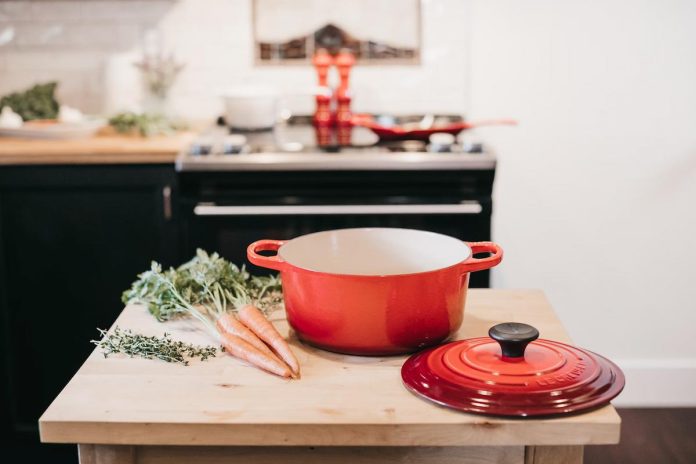Living in a dorm room is an exciting (and sometimes messy) part of the college experience. But between late-night study sessions and the constant scramble for independence, even the simplest tasks like cooking can turn disastrous.
With a little know-how, you can avoid common dorm room kitchen catastrophes and become a dorm room Da Vinci in the culinary arts.
Pressure Cooker Paranoia
Pressure cookers can seem like ticking time bombs in a tiny dorm kitchen. But the truth is, these versatile appliances can be perfectly safe with proper knowledge. Locking lids and pressure release valves are just some of the many safety features seen on modern pressure cookers.
Always follow the manufacturer’s instructions and avoid overfilling the pot. Learn to recognize the different pressure release methods and never force open a locked lid.
However, in recent years, there have been lawsuits filed against some pressure cooker manufacturers due to alleged design defects or inadequate safety warnings. These pressure cooker explosion lawsuits highlight the importance of using caution and following safety guidelines.
LezDo TechMed notes that in November 2022, a California man filed a product liability lawsuit against the Elite Bistro Pressure Cooker manufacturers. He claimed the lid exploded while the cooker was still pressurized, causing burns. TorHoerman Law notes that these lawsuits underscore the importance of using pressure cookers with caution.
With a little effort, your pressure cooker can become your dorm room sous chef, whipping up healthy meals in record time. But remember, even with safety features, it’s crucial to be mindful and follow recommended protocols to ensure a safe and enjoyable cooking experience.
Microwave Mayhem
Microwaves are dorm room lifesavers, but using them carelessly can lead to some sticky situations. Always use microwave-safe containers and stir your food halfway through cooking to ensure even heat distribution. Avoid overheating – frozen meals don’t need to be nuked on high for 10 minutes.
foodie.com suggests that metal is a big no-no as it can cause sparks and fires. The issue with metal is that it also has a large number of freely moving electrons, which are disturbed by microwave radiation. When thin, jagged metal, like a fork or aluminum foil, is placed in a microwave oven, things can go wrong. Such sharp edges turn into dead ends for electrons to accumulate.
Remember, microwaves are for reheating, not full-on cooking experiments. Embrace the simplicity and avoid turning your burrito into a fiery projectile.
Organizing Your Fridge
Firstly, prioritize because fresh produce has a shorter shelf life, so stock up on what you’ll eat first. Invest in small containers to store leftovers and prevent them from spreading their odors.
Leftovers should be consumed within 3-4 days. Spills are inevitable, but clean them up immediately to prevent bacteria growth.
Reader’s Digest states that baking soda is great for absorbing odors – place an open box in the fridge to keep things smelling fresh. By keeping your fridge organized and clean, you’ll avoid unpleasant surprises and midnight fridge raids gone wrong.
How to Cook Properly in an Oven
Before anything else, familiarize yourself with your oven’s temperature settings. The Washington Post notes that ovens can run hot or cold, so start about 25 degrees lower than the recipe suggests and adjust accordingly. Always preheat the oven before placing your food inside – this ensures even cooking.
Invest in oven mitts – burns are no fun, especially in a shared kitchen. Keep aluminum foil on hand – it’s great for catching drips and splatters that can lead to burnt-on messes.
Finally, never leave your oven unattended – set a timer and check on your food regularly. With a little practice, you’ll be baking bread masterpieces that won’t resemble hockey pucks.
FAQs
What happens if I overfill my pressure cooker?
Overfilling a pressure cooker can cause food to block the steam vent, leading to dangerous pressure build-up. This may result in a malfunction or even an explosion. Additionally, overfilled contents can spill, leading to a mess and potential burns from hot steam or food.
How big is a dorm microwave?
Dorm microwaves typically range from 0.7 to 1.5 cubic feet in size. They are designed to be compact and fit easily in small spaces like dorm rooms. Their smaller size is ideal for basic heating and cooking tasks in limited areas.
How long does baking soda absorb odors?
Baking soda typically absorbs odors for about 30 days. Its effectiveness at neutralizing smells decreases as it captures more odors. To maintain optimal freshness, it is recommended to replace the baking soda regularly, ensuring continued odor control and effectiveness.
Mastering dorm room cooking requires a balance of convenience and caution. While pressure cookers can be time-saving marvels, prioritize safety by understanding their operation and following guidelines.
Microwaves are handy for reheating, but proper technique ensures even cooking and avoids scorched surprises. Organization is key for a happy fridge – frequent cleaning, strategic storage, and odor-absorbing solutions will prevent funky smells and wasted food. With a little practice and these tips, you can transform your dorm room into a culinary haven, minus the disasters.


